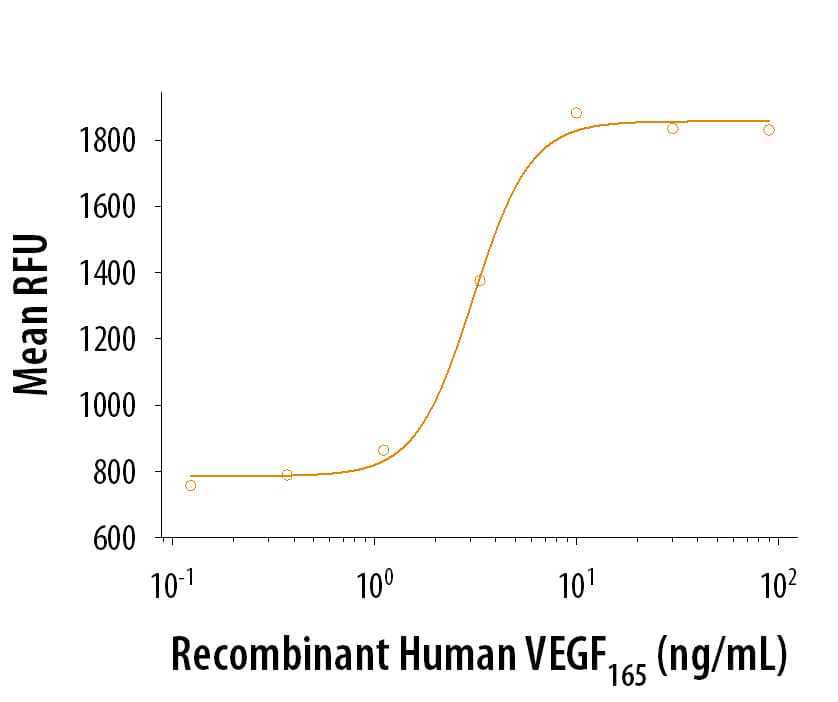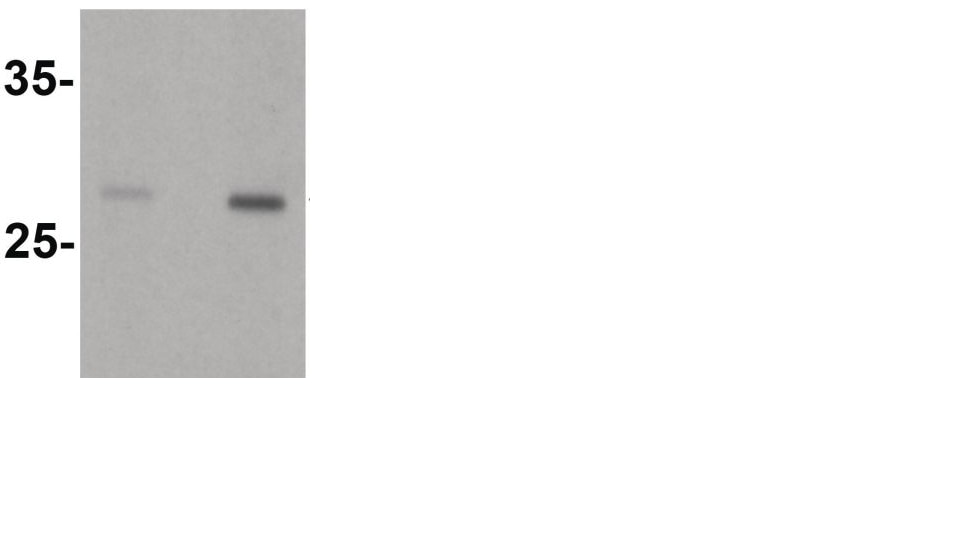Recombinant Human Dectin-1/CLEC7A Protein, CF Summary
Product Specifications
Thr66-Met201, with an N-terminal 10-His tag
Analysis
Customers also Viewed
Product Datasheets
Carrier Free
CF stands for Carrier Free (CF). We typically add Bovine Serum Albumin (BSA) as a carrier protein to our recombinant proteins. Adding a carrier protein enhances protein stability, increases shelf-life, and allows the recombinant protein to be stored at a more dilute concentration. The carrier free version does not contain BSA.
In general, we advise purchasing the recombinant protein with BSA for use in cell or tissue culture, or as an ELISA standard. In contrast, the carrier free protein is recommended for applications, in which the presence of BSA could interfere.
1859-DC
| Formulation | Lyophilized from a 0.2 μm filtered solution in PBS. |
| Reconstitution | Reconstitute at 100 μg/mL in sterile PBS. |
| Shipping | The product is shipped at ambient temperature. Upon receipt, store it immediately at the temperature recommended below. |
| Stability & Storage: | Use a manual defrost freezer and avoid repeated freeze-thaw cycles.
|
Background: Dectin-1/CLEC7A
Dectin-1, also known as CLEC7A and the beta -glucan receptor, is a 33 kDa type II transmembrane C-type lectin that participates in the innate immune response to fungal pathogens. Although Dectin-1 structurally resembles other CLEC molecules, it binds its ligands in a calcium-independent manner (1, 2). Mature human Dectin-1 consists of a short N-terminal ITAM-containing cytoplasmic tail, a transmembrane segment, and a C-terminal stalk with a carbohydrate recognition domain (CRD) in the extracellular domain (3, 4). Alternate splicing generates one major splice form that lacks the stalk region (3 - 5). This isoform is expressed on the surface of monocytes, macrophages, myeloid DC, neutrophils, eosinophils, B cells, and CD4+ T cells (6). The CRD selectively binds beta -glucan polymers, a major component of yeast and mycobacterial cell walls (5 - 7). Yeast beta -glucan is accessible to Dectin-1 only during the process of cell budding. Dectin-1 does not recognize the filamentous form of yeast (8). Dectin-1 mediates the phagocytosis of zymosan particles and intact yeast (8 - 10). In the membrane, Dectin-1 colocalizes with TLR2 in the presence of zymosan, and the two receptors cooperate in ligand recognition and the propagation of proinflammatory signaling (9, 11 - 13). Dectin-1 also interacts with tetraspanin CD37. This increases its stability on the cell membrane and inhibits ligand-induced signaling (14). Dectin-1 knockout mice show increased susceptibility to pathogenic infection (15 - 16). The CRD of human Dectin-1 shares 77%, 60%, and 60% amino acid (aa) sequence identity with that of bovine, mouse and rat Dectin-1, respectively. It shares 29% - 39% aa sequence identity with the CRD of other subgroup members, including CLEC-1, CLEC-2, CLEC9A, CLEC12B, LOX-1, and MICL.
- Kanazawa, N. (2007) J. Dermatol. Sci. 45:77.
- Brown, G.D. (2006) Nat. Rev. Immunol. 6:33.
- Hernanz-Falcon, P. et al. (2001) Immunogenetics 53:288.
- Yokota, K. et al. (2001) Gene 272:51.
- Willment, J.A. et al. (2001) J. Biol. Chem. 276:43818.
- Willment, J.A. et al. (2005) Eur. J. Immunol. 35:1539.
- Palma, A.S. et al. (2006) J. Biol. Chem. 281:5771.
- Gantner, B.N. et al. (2005) EMBO J. 24:1277.
- Gantner, B.N. et al. (2003) J. Exp. Med. 197:1107.
- Kennedy, A.D. et al. (2007) Eur. J. Immunol. 37:467.
- Brown, G.D. et al. (2003) J. Exp. Med. 197:1119.
- Yadav, M. and J.S. Schorey (2006) Blood 108:3168.
- Suram, S. et al. (2006) J. Biol. Chem. 281:5506.
- Meyer-Wentrup, F. et al. (2007) J. Immunol. 178:154.
- Saijo, S. et al. (2007) Nat. Immunol. 8:39.
- Taylor, P.R. et al. (2007) Nat. Immunol. 8:31.
Citations for Recombinant Human Dectin-1/CLEC7A Protein, CF
R&D Systems personnel manually curate a database that contains references using R&D Systems products. The data collected includes not only links to publications in PubMed, but also provides information about sample types, species, and experimental conditions.
9
Citations: Showing 1 - 9
Filter your results:
Filter by:
-
Alteration of microbiota antibody-mediated immune selection contributes to dysbiosis in inflammatory bowel diseases
Authors: E Michaud, L Waeckel, R Gayet, R Goguyer-De, B Chanut, F Jospin, K Bathany, M Monnoye, C Genet, A Prier, C Tokarski, P Gérard, X Roblin, N Rochereau, S Paul
Embo Molecular Medicine, 2022-07-04;0(0):e15386.
Species: Human
Sample Types: Stool
Applications: Bioassay -
Functionally modified chitotriosidase catalytic domain for chitin detection based on split-luciferase complementation
Authors: D Yamanaka, K Suzuki, M Kimura, F Oyama, Y Adachi
Carbohydrate polymers, 2022-01-12;282(0):119125.
Species: N/A
Sample Types: Recombinant Protein
Applications: Bioassay -
LYSMD3: A mammalian pattern recognition receptor for chitin
Authors: X He, BA Howard, Y Liu, AK Neumann, L Li, N Menon, T Roach, SD Kale, DC Samuels, H Li, T Kite, H Kita, TY Hu, M Luo, CN Jones, UJ Okaa, DL Squillace, BS Klein, CB Lawrence
Cell Reports, 2021-07-20;36(3):109392.
Species: Human
Sample Types: Whole Cells
Applications: Bioassay -
Molecular basis for intestinal mucin recognition by galectin-3 and C-type lectins
Authors: C Leclaire, K Lecointe, PA Gunning, S Tribolo, DW Kavanaugh, A Wittmann, D Latousakis, DA MacKenzie, N Kawasaki, N Juge
FASEB J., 2018-01-29;0(0):fj201700619R.
Species: Human
Sample Types: Recombinant Protein
Applications: Bioassay -
Differential susceptibility of Dectin-1 isoforms to functional inactivation by neutrophil and fungal proteases
Authors: JS Griffiths, A Thompson, M Stott, A Benny, NA Lewis, PR Taylor, J Forton, S Herrick, SJ Orr, EP McGreal
FASEB J., 2018-01-22;0(0):fj201701145R.
Species: Human
Sample Types: Recombinant Protein
Applications: Bioassay -
Immunoregulatory Activity of the Natural Product Laminarin Varies Widely as a Result of Its Physical Properties
Authors: AJ Smith, B Graves, R Child, PJ Rice, Z Ma, DW Lowman, HE Ensley, KT Ryter, JT Evans, DL Williams
J. Immunol., 2017-12-15;0(0):.
Applications: Bioassay -
Lactobacillus reuteri Surface Mucus Adhesins Upregulate Inflammatory Responses Through Interactions With Innate C-Type Lectin Receptors
Authors: KP Bene, DW Kavanaugh, C Leclaire, AP Gunning, DA MacKenzie, A Wittmann, ID Young, N Kawasaki, E Rajnavolgy, N Juge
Front Microbiol, 2017-03-07;8(0):321.
Species: Human
Sample Types: Whole Cells
Applications: Bioassay -
FleA Expression in Aspergillus fumigatus Is Recognized by Fucosylated Structures on Mucins and Macrophages to Prevent Lung Infection
Authors: SC Kerr, GJ Fischer, M Sinha, O McCabe, JM Palmer, T Choera, F Yun Lim, M Wimmerova, SD Carrington, S Yuan, CA Lowell, S Oscarson, NP Keller, JV Fahy
PLoS Pathog, 2016-04-08;12(4):e1005555.
Species: Fungus
Sample Types: Whole Cells
Applications: Flow Cytometry -
Correction: A chitin-like component on sclerotic cells of fonsecaea pedrosoi inhibits dectin-1-mediated murine Th17 development by masking beta-glucans.
PLoS ONE, 2015-03-18;10(3):e0119244.
Species: Human
Sample Types: Whole Cells
Applications: Bioassay
FAQs
No product specific FAQs exist for this product, however you may
View all Proteins and Enzyme FAQsReconstitution Buffers
Reviews for Recombinant Human Dectin-1/CLEC7A Protein, CF
Average Rating: 4 (Based on 1 Review)
Have you used Recombinant Human Dectin-1/CLEC7A Protein, CF?
Submit a review and receive an Amazon gift card.
$25/€18/£15/$25CAN/¥75 Yuan/¥2500 Yen for a review with an image
$10/€7/£6/$10 CAD/¥70 Yuan/¥1110 Yen for a review without an image
Filter by:













